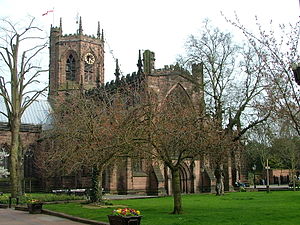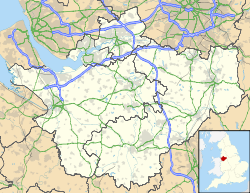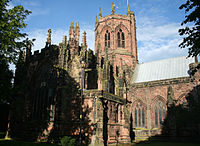- St Mary's Church, Nantwich
-
St Mary's Church, Nantwich
St Mary's Church, NantwichLocation in Cheshire Coordinates: 53°04′02″N 2°31′14″W / 53.0671°N 2.5206°W OS grid reference SJ 651 523 Location Nantwich, Cheshire Country England Denomination Anglican Website St Mary's, Nantwich Architecture Status Parish church Functional status Active Heritage designation Grade I Designated 19 April 1948 Architect(s) George Gilbert Scott (restoration) Architectural type Church Style Gothic Specifications Height 101 feet (31 m) Materials Red sandstone Administration Parish Nantwich Deanery Nantwich Archdeaconry Macclesfield Diocese Chester Province York Clergy Rector Rev Peter Chantry Laity Director of music Tony Metcalfe Churchwarden(s) Jenny O'Brien,
Michael WaldenParish administrator Sylvia Reynolds,
Miriam HarveySt Mary's Church, Nantwich, is in the centre of the market town of Nantwich, Cheshire, England.[1] The church has been designated by English Heritage as a Grade I listed building.[2] It has been called the "Cathedral of South Cheshire" and it is considered by some to be one of the finest medieval churches, not only in Cheshire, but in the whole of England.[3] The architectural writer Raymond Richards described it as "one of the great architectural treasures of Cheshire",[4] and Alec Clifton-Taylor included it in his list of "outstanding" English parish churches.[5]
The building dates from the 14th century, although a number of changes have since been made, particularly a substantial 19th-century restoration by Sir George Gilbert Scott. The church and its octagonal tower are built in red sandstone. Features of the church's interior include the lierne-vaulted ceiling of the choir, the carved stone canopies of the sedilia in the chancel, and the intricately carved wooden canopies over the choirstalls together with the 20 misericords at the back of the stalls. The church is an active Anglican parish church in the diocese of Chester, the archdeaconry of Macclesfield and the deanery of Nantwich.[6]
Contents
History
The first building on the site was a chapel of ease in the parish of Acton. In about 1130 both Acton church and Northwich chapel came under control of the Cistercian abbey of Combermere.[7] The building of the present church started in about 1340 in the Decorated style, which was the style most commonly used in English church building at that time. The masons, who came from Yorkshire, used local sandstone, probably from Eddisbury near Delamere. Building work was interrupted between 1349 and 1369, probably due to an outbreak of the Black Death plague. By the 1380s the town's prosperity had recovered and building work resumed. This phase of construction was carried out by master masons associated with Lichfield and Gloucester cathedrals, now building in the Perpendicular style.[8] The south transept was endowed as a chantry chapel in 1405.[4] In the late-15th or early-16th century, the south porch was added, the nave roof was raised and the clerestory windows were added. Following the dissolution of the monasteries, six chantry chapels were removed in 1548. Between 1572 and 1577 the transept ceilings were renewed, and between 1615 and 1633 the church floor was raised because of flooding, a west gallery was built, and the walls were painted white, with the addition of scriptural texts.[8] The church was briefly used as a prison for Royalists captured at the battles of Nantwich and Preston during the Civil War.
Between 1727 and 1777, the north and south galleries and a new west door were added, and windows were repaired. However, by 1789 the general structure of the church had deteriorated so much that it was said to be "so ruinous that the inhabitants cannot safely assemble".[9] In the 19th century Sir George Gilbert Scott was brought in to direct a very extensive restoration. Amongst other alterations, he removed the galleries, the box pews, and many old memorials; the floor level was lowered and the transept roofs were pitched higher.[9] Much of the eroded stone was replaced by sandstone from quarries at Runcorn,[10] but not everyone was happy with the scale and nature of Scott's restoration. The architectural historian Nikolaus Pevsner complained about the replacement of a Decorated doorway and a Perpendicular window with corresponding structures in the style of the late-13th century.[11] The local representative of the Society for the Protection of Ancient Buildings at the time was of the opinion that "Very great injury was done to this Church in the Restoration ...".[12] Clifton-Taylor complained about the way in which part of the church walls have subsequently been pointed.[13] The last major work to be carried out on the church was in 1878, under the direction of local architect Thomas Bower, when the south porch was restored at a cost of £900 (£60,000 as of 2011).[12][14]
Architecture
Exterior
The church is built in red sandstone and is cruciform in shape. Its plan consists of a four-bay nave with north and south aisles, a south porch with two storeys, a central tower, north and south transepts, and a three-bay chancel, to the north of which is a two-storey treasury. The tower is square below and octagonal above. Both transepts are of three bays and the northernmost bay of the north transept was formerly a Lady Chapel. The other two bays were dedicated to Saint George. The south transept was known as the Kingsley Chapel.[4] Pevsner, in addition to complaining about some aspects of Scott's restoration, comments on the abrupt change from the Decorated to the Perpendicular style, no doubt the consequence of the interruption to building work caused by the Black Death. This is particularly so in the chancel where the side windows are "very rich Decorated", with crocketed gables and highly decorated buttresses and pinnacles, while the seven-light east window, also under a crocketed gable, is "pure Perpendicular". The aisle windows and all the windows in the north transept are Decorated, while in the south transept one window is Decorated and all the others are Perpendicular. The bell-openings in the tower are Decorated. Pevsner describes the tower as being the "crowning motif" of the church.[11]
Interior
The south wall of the nave shows the line of the original roof before it was raised, and contains faint remains of paintings dating from the 19th century, which consist of scriptural inscriptions. In the nave is a Jacobean pulpit, designed by Thomas Finch and made in 1601, which was once part of a three-decker pulpit. It was damaged in 1683 by a falling roof beam and was reduced in the 1855 restoration. Hanging on the wall of the nave are a number of Tudor boards which were taken from the ceiling of the south transept in 1964; one of these is dated 1577.[15] In the south aisle is a small painting of The Widow's Mite by Jules Bouvier.[11] A second pulpit, made of stone and dating from the late-14th century, is attached to the northeast pier of the crossing. This is designed to appear like a large chalice, and is decorated with panel tracery. The wooden crossing vault was designed by Scott. The roof of the north transept is also wooden, but of Tudor design. In the north wall of the transept is an aumbry and in the northeast corner is an oven with a chimney, which was used for baking Communion wafers. The transept contains an oak chest dated 1676 and a bench dated 1737.[16] In the east wall of north transept are a piscina and another aumbry.[4]
There is another piscina in the south transept, although this is damaged, along with an alabaster effigy of Sir David Craddock, who died in about 1384. The effigy was damaged in the Civil War, and was found buried under the chancel floor during the 19th-century restoration.[4] Sir David, who came from Nantwich, was once Mayor of Bordeaux, Justicar of Wales and a money-lender to Richard II.[17] The south transept also contains a tomb dated 1614, which was transferred from the former St Chad's Church, Wybunbury in 1982. This is constructed of alabaster and limestone and includes effigies of Sir Thomas Smith, mayor and sheriff of Chester, and his wife, Anne. In addition the transept contains a number of brass memorials.[17] At the back of the church along the west wall are the Jubilee curtains which were made by the church's Tapestry Group to commemorate the silver jubilee of Elizabeth II in 1977.[18] In the porch the stone vaulting dates from 1879 and it contains the carving of a green man, while on the outside of the porch are carvings of the Four Evangelists. The room over the porch houses a library of theological books, including a complete edition (which is thought to be unique) of the Sarum Hymns and Sequences, printed in 1539 by Wynkyn de Worde.[19]
Chancel
The ceiling of the chancel consists of a stone lierne vault with almost 70 carved bosses dating from the 14th century. The eastern bosses depict the life of Mary and the western ones Christ's Passion and Resurrection. Over each choirstall is a carved wooden triple-arched canopy.[20] The canopies are described as having "a complexity unsurpassed in English medieval woodcarving".[20] Clifton-Taylor considered that they are the finest in the country, although he complained that they have been stained nearly black.[21] At the lower ends of the canopies are Victorian carvings of angels, grotesques and foliage and below these are carvings on corbels of subjects such as mermaids, centaurs, wyverns and musical angels. At the back of the choirstalls are 20 misericords which date from the early–mid 15th century. Under of each of these is a different carving; the subjects include Saint George and the Dragon, the Virgin and a unicorn, and a pelican with her brood. At the ends of the choirstalls are carvings of poppyheads, wyverns and a green man.[20] The altar table is Elizabethan and is dated 1638. In the north wall of the sanctuary is an aumbry and on the opposite wall are a canopied piscina and a triple sedilia, also with canopies.[4] These canopies are described as being "among the showpieces of the 14th century masons".[22] The reredos was dedicated in 1919 and contains carvings of Christ on the Cross, Mary and John, and the four national saints, Saints George, Andrew, Patrick and David. The canopies above them echo those of the choirstalls.[23]
Stained glass and other features
The stained glass in the west window dates from 1875; it was made by Clayton and Bell and depicts the Presentation of Jesus at the Temple. Also by Clayton and Bell is a window at the west end of the north wall of the nave depicting Enoch, Noah, Job and Abel. To the east of this is a window designed by Michael Farrar-Bell dated 1985, to the memory of a local farmer, depicting the Creation. Beyond this is a window from 1901 made by Reuben Bennett which depicts the Good Shepherd with David and Miriam. On the south wall of the nave is a window from 1919 by Harry Clarke depicting Richard Coeur-de-Lion, saints and military emblems. In other windows on the south wall there are fragments of old glass.[15] The north wall of the north transept contains a window with stained glass by Kempe which incorporates some pieces of medieval glass and depicts the Tree of Jesse. On the east wall of the transept are two windows by John Hardman which date from 1862 and 1864. The south transept contains a window dating from 1855 with stained glass by William Wailes.[24] The east window was reglazed in 1876 by Clayton and Bell; it shows episodes from the life of Christ with figures of apostles and prophets.[23] In the porch is more stained glass by Kempe, dating from 1878.[19]
The original organ was moved from its central position in the crossing to the north transept during Scott's restoration. The instrument performed badly following the move, which was attributed to the cold and dampness of its new position. Consequently it was moved to the south transept, but it performed no better there, and in 1889 it was sold to Haydock church.[25] The present organ was built in 1890 by Forster and Andrews and partly rebuilt in about 1925.[26] It was again rebuilt in 1973 by Charles Whiteley and Company, who installed electro-pneumatic action among other additions and repairs. Rushworth and Dreaper made further additions during their 1994 restoration.[27] The parish registers date back to 1539 and contain much material relating to Nantwich's history.[19] The ring consists of eight bells, four of which were cast by Rudhall of Gloucester in 1713, and the other four by John Taylor and Company in 1922.[28]
Present day
The church runs a number of services each Sunday, some of which are traditional in nature, while others are more evangelical.[29] During the week there are activities for children and the youth of the parish and town[30] and for adults.[31] The rector is Rev. Peter Chantry, the curate is Rev. Tim Watson and the Director of Music is Tony Metcalfe.[32] Various events, including concerts, are held in the church.[33] Nantwich Choral Society perform in a number of venues and its "chosen venue" is St Mary's because "its acoustics are superb".[34] In 2005 the church's congregation were the champions in Songs from the Aisles, organised by BBC Radio Stoke.[35]
See also
References
- ^ Nantwich, Streetmap, http://streetmap.co.uk/grid/365120_352367_120, retrieved 17 January 2011
- ^ "Church of St Mary, Nantwich", The National Heritage List for England (English Heritage), 2011, http://list.english-heritage.org.uk/resultsingle.aspx?uid=1206059, retrieved 29 April 2011
- ^ Bilsborough 1983, pp. 155–157.
- ^ a b c d e f Richards 1947, pp. 248–254.
- ^ Clifton-Taylor 1974, p. 240.
- ^ St Mary, Nantwich, Church of England, http://www.achurchnearyou.com/nantwich-st-mary/, retrieved 17 January 2011
- ^ Nantwich Web, Netnous, http://www.nantwichweb.com/history/stmarys.htm, retrieved 27 July 2007
- ^ a b Pritchard 1991, pp. 2–3.
- ^ a b Pritchard 1991, p. 3.
- ^ Starkey 1990, p. 149.
- ^ a b c Pevsner & Hubbard 2003, pp. 285–287.
- ^ a b Ball 1986, p. 13.
- ^ Clifton-Taylor 1974, p. 69.
- ^ UK CPI inflation numbers based on data available from Lawrence H. Officer (2010) "What Were the UK Earnings and Prices Then?" MeasuringWorth.
- ^ a b Pritchard 1991, pp. 4–5.
- ^ Pritchard 1991, pp. 6–7.
- ^ a b Pritchard 1991, p. 8.
- ^ The Tapestry Group, St Marys Nantwich, http://www.stmarysnantwich.org.uk/church_building.php#jubilee_curtain, retrieved 22 September 2008
- ^ a b c Pritchard 1991, p. 12.
- ^ a b c Pritchard 1991, p. 11.
- ^ Clifton-Taylor 1974, pp. 182–183.
- ^ Hutton 1979, p. 76.
- ^ a b Pritchard 1991, p. 10.
- ^ Pritchard 1991, pp. 6–8.
- ^ Ball 1986, pp. 14, 16.
- ^ Nantwich St. Mary (N04317), British Institute of Organ Studies, http://www.npor.org.uk/cgi-bin/Rsearch.cgi?Fn=Rsearch&rec_index=N04317, retrieved 11 August 2008
- ^ Nantwich St. Mary (N04318), British Institute of Organ Studies, http://www.npor.org.uk/cgi-bin/Rsearch.cgi?Fn=Rsearch&rec_index=N04318, retrieved 11 August 2008
- ^ Nantwich S Mary, Dove's Guide for Church Bell Ringers, http://dove.cccbr.org.uk/detail.php?searchString=Nantwich&Submit=++Go++&DoveID=NANTWICH, retrieved 11 August 2008
- ^ Worship at St Mary's Nantwich, St Mary's Nantwich, http://stmarysnantwich.org.uk/worship/, retrieved 19 October 2011
- ^ Young people, St Mary's Nantwich, http://stmarysnantwich.org.uk/young-people/, retrieved 19 October 2011
- ^ Branch Groups, St Mary's Nantwich, http://stmarysnantwich.org.uk/worship/homegroups/, retrieved 19 October 2011
- ^ Who's Who, St Mary's Nantwich, http://stmarysnantwich.org.uk/about-st-marys/whos-who/, retrieved 19 October 2011
- ^ Forthcoming Events at St Mary's Nantwich, St Mary's Nantwich, http://stmarysnantwich.org.uk/events/, retrieved 19 October 2011
- ^ Our Choir, Nantwich Choral Society, http://www.nantwichchoral.org.uk/aboutus/Our_Choir.htm, retrieved 19 October 2011
- ^ Penfold, Simon (2005), Songs from the Aisles - our congregation competition, BBC Stoke and Staffordshire, http://www.bbc.co.uk/stoke/content/articles/2004/12/20/faith_songs_from_the_aisles_feature.shtml, retrieved 22 September 2008
- Bibliography
- Ball, Nancy (1986), Nantwich Victorian Parish 1872–1894, Nantwich: The Rector and Churchwardens of St Mary's, Nantwich
- Bilsborough, Norman (1983), The Treasures of Cheshire, Manchester: The North West Civic Trust, ISBN 0901347353
- Clifton-Taylor, Alec (1974), English Parish Churches as Work of Art, London: Batsford, ISBN 0-7134-2776-0
- Hutton, Graham; Olive Cook (1979), English Parish Churches, New York: Thames and Hudson
- Pevsner, Nikolaus; Hubbard, Edward (2003) [1971], Cheshire, The Buildings of England, New Haven and London: Yale University Press, ISBN 0-300-09588-0
- Pritchard, R. E. (1991), St Mary's Nantwich, Andover: Pitkin Pictorials, ISBN 0-85372-538-1
- Richards, Raymond (1947), Old Cheshire Churches, London: B. T Batsford
- Starkey, H. F. (1990), Old Runcorn, Halton: Halton Borough Council
Further reading
- Pritchard, R. E, The Choir and Misericords of St. Mary's, Nantwich
External links
- Photographs of the church building and activities
- Photographs by Craig Thornber of the church's architecture
- Photographs by Craig Thornber of the furnishings and monuments
- Corpus Vitrearum Medii Aevi of Great Britain (stained glass)
Categories:- Church of England churches in Cheshire
- English Gothic architecture
- Grade I listed churches
- Grade I listed buildings in Cheshire
- Diocese of Chester
- Nantwich
Wikimedia Foundation. 2010.



